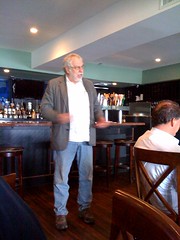A few months ago i read the book Elsewhere USA at danah boyd’s suggestion. It didn’t disappoint. While it wasn’t as good as last year’s Generation Me (which i couldn’t stop blogging about), it did have some good insights.
The point of the book is the strange paradox that is occuring in America. People used to work and struggle so their kids wouldn’t have to. Leiseure was something you attained at a certain income level. Today however, this isn’t the case. For the first time in history, the more we are paid, the more hours we work. The rewards for working are so great they make the “opportunity cost” of not working all the more great. The result is that there is no longer a leisure-class of elites. The rich are working harder than ever. Now, leisure is something for the poor. There is now a crazy measure of the income elasticity of leisure and this fundamentally changes how many of us (including me) live. As it says in the book, 
Obviously, this change has affected not just when we work, but also how we play, how we love, how we raise our children – how we live
Some interesting parts in the book are:
- There’s now a fear amoung the successful that their success isn’t geniune and an axiety that a person’s personal house of economic card is about to collapse. One interesting stat behind this is that while drinking has declined, adult use of other mind-altering substances such as Valium or marajuana has risen to the point where mature adults consume more than teenagers for the first time since these trends were tracked
- More and more, household income rising and falling has less to do with economic times but more about relationships. About a quarter of American children experience two or more mother’s partners by the time they are fifteen. Over 8 percent experience three or more
- Similar to the African areas of Mali and Malawi, America also practices a form of polygamy. Post coming on this soon….
- Religion and The Corporate man have been at odds. A further description below:
In medieval Cathoic Europe, poverty was a virtue and to profit off one’s fellow man was considered evil. The Protestant Reformation changed all that which led to one-on-one relationships to go and also spiritual insecurity. This led to working harder and acculating lots of money. Success as salvation was a new incentive structure. However, the Great Depression, the New Deal, and the trade unionism eclipsed the Protestant Work Ethic in the mid 1900’s. There was a truce found between expansive corporate America and organzied labor such that a communitarian eithos could reign supreme.
The rift remained though as Protestants valued thrift over consumption, work over leisure, and meritocracy over social connections. But large organizations like IBM and GM put a premium on teamwork, compromise and being a “company man.”
Today these have been resolved through the redefinition of: leisure is work and work is leisure. Consumption is investment (home equity loan is savings). Social connectoins don’t indicate nepotism but rather social capital and entrepreneurial skill. Loyalty is replaced by value (you show your value by calculated displays of disloyalty – displaying offers from competitors).
——-
While it doesn’t offer many solutions, the book is thought provoking and a good read. I recommend you pick it up.
 TV and traditional ad spending for Nike is down 80% over the past 4 years where as digital spend is up 200%. They want to go where the consumers are and more and more that is online
TV and traditional ad spending for Nike is down 80% over the past 4 years where as digital spend is up 200%. They want to go where the consumers are and more and more that is online![Reblog this post [with Zemanta]](http://img.zemanta.com/reblog_c.png?x-id=fcf9e54b-d267-4145-8492-607af9a5862d)



![Reblog this post [with Zemanta]](http://img.zemanta.com/reblog_e.png?x-id=9a03ea2f-be26-4b25-9762-93614d88184e)

![Reblog this post [with Zemanta]](http://img.zemanta.com/reblog_e.png?x-id=88f15572-14e7-41bf-bcd2-6b58fdfd23b7)

